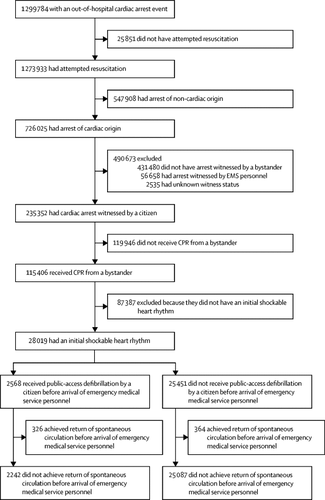Our official English website, www.x-mol.net, welcomes your
feedback! (Note: you will need to create a separate account there.)
Public-access defibrillation and neurological outcomes in patients with out-of-hospital cardiac arrest in Japan: a population-based cohort study.
The Lancet ( IF 98.4 ) Pub Date : 2019-12-17 , DOI: 10.1016/s0140-6736(19)32488-2 Takahiro Nakashima 1 , Teruo Noguchi 1 , Yoshio Tahara 1 , Kunihiro Nishimura 1 , Satoshi Yasuda 1 , Daisuke Onozuka 2 , Taku Iwami 3 , Naohiro Yonemoto 4 , Ken Nagao 5 , Hiroshi Nonogi 6 , Takanori Ikeda 7 , Naoki Sato 8 , Hiroyuki Tsutsui 9 ,
The Lancet ( IF 98.4 ) Pub Date : 2019-12-17 , DOI: 10.1016/s0140-6736(19)32488-2 Takahiro Nakashima 1 , Teruo Noguchi 1 , Yoshio Tahara 1 , Kunihiro Nishimura 1 , Satoshi Yasuda 1 , Daisuke Onozuka 2 , Taku Iwami 3 , Naohiro Yonemoto 4 , Ken Nagao 5 , Hiroshi Nonogi 6 , Takanori Ikeda 7 , Naoki Sato 8 , Hiroyuki Tsutsui 9 ,
Affiliation

|
BACKGROUND
More than 80% of public-access defibrillation attempts do not result in sustained return of spontaneous circulation in patients who have had an out-of-hospital cardiac arrest (OHCA) and a shockable heart rhythm before arrival of emergency medical service (EMS) personnel. Neurological and survival outcomes in such patients have not been evaluated. We aimed to assess the neurological status and survival outcomes in such patients.
METHODS
This is a retropective analysis of a cohort study from a prospective, nationwide, population-based registry of 1 299 784 patients who had an OHCA event between Jan 1, 2005, and Dec 31, 2015 in Japan. The primary outcome was favourable neurological outcome (Cerebral Performance Category of 1 or 2) at 30 days after the OHCA and the secondary outcome was survival at 30 days following the OHCA. This study is registered with the University Hospital Medical Information Network Clinical Trials Registry, UMIN000009918.
FINDINGS
We identified 28 019 patients with bystander-witnessed OHCA and shockable heart rhythm who had received CPR from a bystander. Of these, 2242 (8·0%) patients did not achieve return of spontaneous circulation with CPR plus public-access defibrillation, and 25 087 (89·5%) patients did not achieve return of spontaneous circulation with CPR alone before EMS arrival. The proportion of patients with a favourable neurological outcome was significantly higher in those who received public-access defibrillation than those who did not (845 [37·7%] vs 5676 [22·6%]; adjusted odds ratio [OR] after propensity score-matching, 1·45 [95% CI 1·24-1·69], p<0·0001). The proportion of patients who survived at 30 days after the OHCA was also significantly higher in those who received public-access defibrillation than those who did not (987 [44·0%] vs 7976 [31·8%]; adjusted OR after propensity score-matching, 1·31 [95% CI 1·13-1·52], p<0·0001).
INTERPRETATION
Our findings support the benefits of public-access defibrillation and greater accessibility and availability of automated external defibrillators in the community.
FUNDING
None.
中文翻译:

日本院外心脏骤停患者的公共除颤和神经功能预后:一项基于人群的队列研究。
背景技术超过80%的公共除颤尝试并未导致在急诊服务(EMS)到来之前出现院外心脏骤停(OHCA)和心律不稳的患者持续自发性循环人员。尚未评估此类患者的神经和生存结局。我们旨在评估此类患者的神经系统状况和生存结果。方法这是一项前瞻性,回顾性分析,该研究来自一项前瞻性,全国性,基于人群的登记研究,研究对象是日本1 299 784名在2005年1月1日至2015年12月31日期间发生OHCA事件的患者。主要结局是在OHCA后30天的神经系统结局良好(脑功能类别为1或2),次要结局是在OHCA后30天生存。该研究已在大学医院医学信息网络临床试验注册中心(UMIN000009918)注册。结果我们确定了28 019例由旁观者见证的OHCA和令人震惊的心律的患者,这些患者从旁观者那里接受了心肺复苏术。其中2242例(8·0%)患者未通过CPR加公共除纤颤术实现自发性循环恢复,而25 087例(89·5%)患者在EMS到达前仅通过CPR未能实现自发性循环恢复。接受公共除颤的患者中,具有良好神经学预后的患者比例显着高于未接受公共除颤的患者(845 [37·7%] vs 5676 [22·6%];倾向后的校正比值比[OR]得分匹配1·45 [95%CI 1·24-1·69],p <0·0001)。OHCA术后30天存活的患者比例也比未接受OHAF的患者显着更高(987 [44·0%] vs 7976 [31·8%];倾向性后调整OR得分匹配1·31 [95%CI 1·13-1·52],p <0·0001)。解释我们的研究结果支持公共除颤的好处,以及社区中自动体外除颤器的更大可及性和可用性。资金无。解释我们的研究结果支持公共除颤的好处,以及社区中自动体外除颤器的更大可及性和可用性。资金无。解释我们的研究结果支持公共除颤的好处,以及社区中自动体外除颤器的更大可及性和可用性。资金无。
更新日期:2019-12-20
中文翻译:

日本院外心脏骤停患者的公共除颤和神经功能预后:一项基于人群的队列研究。
背景技术超过80%的公共除颤尝试并未导致在急诊服务(EMS)到来之前出现院外心脏骤停(OHCA)和心律不稳的患者持续自发性循环人员。尚未评估此类患者的神经和生存结局。我们旨在评估此类患者的神经系统状况和生存结果。方法这是一项前瞻性,回顾性分析,该研究来自一项前瞻性,全国性,基于人群的登记研究,研究对象是日本1 299 784名在2005年1月1日至2015年12月31日期间发生OHCA事件的患者。主要结局是在OHCA后30天的神经系统结局良好(脑功能类别为1或2),次要结局是在OHCA后30天生存。该研究已在大学医院医学信息网络临床试验注册中心(UMIN000009918)注册。结果我们确定了28 019例由旁观者见证的OHCA和令人震惊的心律的患者,这些患者从旁观者那里接受了心肺复苏术。其中2242例(8·0%)患者未通过CPR加公共除纤颤术实现自发性循环恢复,而25 087例(89·5%)患者在EMS到达前仅通过CPR未能实现自发性循环恢复。接受公共除颤的患者中,具有良好神经学预后的患者比例显着高于未接受公共除颤的患者(845 [37·7%] vs 5676 [22·6%];倾向后的校正比值比[OR]得分匹配1·45 [95%CI 1·24-1·69],p <0·0001)。OHCA术后30天存活的患者比例也比未接受OHAF的患者显着更高(987 [44·0%] vs 7976 [31·8%];倾向性后调整OR得分匹配1·31 [95%CI 1·13-1·52],p <0·0001)。解释我们的研究结果支持公共除颤的好处,以及社区中自动体外除颤器的更大可及性和可用性。资金无。解释我们的研究结果支持公共除颤的好处,以及社区中自动体外除颤器的更大可及性和可用性。资金无。解释我们的研究结果支持公共除颤的好处,以及社区中自动体外除颤器的更大可及性和可用性。资金无。











































 京公网安备 11010802027423号
京公网安备 11010802027423号